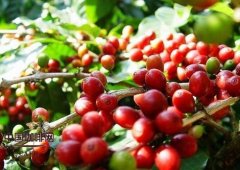The coffee bean producing areas of Hawaii, the western and southern parts of Kona region
Whether it's bean-shaped, dry, wet, chocolate, vanilla, tangerine, lavender, etc., the most obvious feeling this coffee gives me is amazing! And its sweetness is no less, every now and then when my taste buds think it is about to fade, a proud announcement that this is its territory emerges. Hawaii is the largest island in the Hawaiian Islands, so it is also called the Big Island. Kona coffee is grown in the west and south of Kona area of Hawaii Island. Coffee trees are spread all over the slopes of Hualalai and Mauna Loa, which are 150 meters to 750 meters above sea level, which is suitable for coffee growth.
The excellent quality of Kona coffee is due to its location and climate. Coffee trees grow on the slopes of volcanoes, and their geographical location ensures the altitude required for coffee growth; the dark volcanic ash soil provides the minerals needed for coffee growth; the climatic conditions are very suitable, and the sun gently passes through the air filled with moisture in the morning. In the afternoon, the mountains become more humid and foggy, and the clouds in the air are natural umbrellas for coffee trees. At night, they become clear and cool, but no frost falls. Natural conditions have allowed the average yield of Kona coffee to be very high, reaching 2240 kilograms per hectare, compared with 600 to 900 kilograms per hectare in Latin America.
In 1813, a Spaniard first planted coffee in Oahu's Manoa Valley, which today is the main campus of the University of Hawaii. In 1825, an English agriculturist named John Wilkinson transplanted coffee seeds from Brazil to the coffee plantation of Chief Birch on Oahu. Three years later, an American missionary named Samuel Reverend Ruggles brought branches from Chief Birch's coffee tree to Kona. The coffee is a descendant of the Arabica coffee tree originally grown in the Ethiopian highlands, and Kona coffee continues its noble and ancient lineage to this day

Important Notice :
前街咖啡 FrontStreet Coffee has moved to new addredd:
FrontStreet Coffee Address: 315,Donghua East Road,GuangZhou
Tel:020 38364473
- Prev

Coffee beans of Ecuador, Arabica, the highest altitude in the world.
Boutique coffee has a strict grading system. Generally, raw beans are preserved in parchment coffee beans in the form of endocarp after processing, and the endocarp is removed before export. Go through a strict grading process to ensure the uniformity of quality. And it is very important to preserve the protection in the process of transportation, such as the control of temperature and humidity, the control of ventilation, avoiding odor adsorption and so on.
- Next

Venezuelan Coffee producing Andes Coffee Plantation
One of the many plantations in Merida at the foot of the Andes belongs to the Pablo and Pulido families, an ancient farm that has been allowed to downsize. Since taking over the farm in the early 1980s, the Pulido family has harvested coffee from existing bourbon coffee trees and planted new tree species to expand farming.
Related
- Does Rose Summer choose Blue, Green or Red? Detailed explanation of Rose Summer Coffee plots and Classification in Panamanian Jade Manor
- What is the difference between the origin, producing area, processing plant, cooperative and manor of coffee beans?
- How fine does the espresso powder fit? how to grind the espresso?
- Sca coffee roasting degree color card coffee roasting degree 8 roasting color values what do you mean?
- The practice of lattes: how to make lattes at home
- Introduction to Indonesian Fine Coffee beans-- Java Coffee producing area of Indonesian Arabica Coffee
- How much will the flavor of light and medium roasted rose summer be expressed? What baking level is rose summer suitable for?
- Introduction to the characteristics of washing, sun-drying or wet-planing coffee commonly used in Mantenin, Indonesia
- Price characteristics of Arabica Coffee Bean Starbucks introduction to Manning Coffee Bean Taste producing area Variety Manor
- What is the authentic Yega flavor? What are the flavor characteristics of the really excellent Yejasuffi coffee beans?

